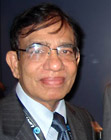
Meditation, not Medication, for Stress - Part I

Life comes in different packages to different people. Some are lucky to go through their days without major problems. But for many of us, challenges abound in our daily lives and dealing with these challenges generates a lot of unnecessary stress. However, if we face our daily struggles with a degree of equanimity and common sense, we can live a happy life.
Easily said than done, right? Well, that is where the discipline of ‘meditation’ comes in.
What is meditation?
“Meditation is a conscious effort to change how the mind works,” said Lord Buddha, one of the original proponents of this great discipline. The main purpose is to keep your mind steady and strong, relaxed and peaceful. Mindful meditation definitely improves your brain function helping you to stay focused on whatever you are doing. Then you can think better, act properly, lessen reactivity to unpleasant situations, increase productivity and improve creativity.
Our ancient sages and saints spent a lot of time in meditation to achieve the perfect union of mind and body or Yoga. And as Sage Patanjali said, “Yogaschithavritthi nirodha” (Yoga is the control of thought waves in the mind).
Volumes have been written on the subject — how to do, when and where to do, what to wear, what to listen, etc. But let us not make it too complicated. Just remember the four important ‘P’s if you are planning to be initiated into the discipline.
-
Place: Find a suitable place – a quiet corner in the house, perhaps a prayer room or even a scenic spot outside, so you would be left undisturbed. An advanced student can even do it while traveling in a crowded bus or plane.
-
Posture: Sit in a comfortable posture with legs crossed as in ‘sukhasana.’ Padmasana or lotus pose for those who are flexible and able to do. You can also do it in a chair or even lying down.
-
Practice: This involves sitting quietly, closing your eyes and focusing your attention on your breathing. With your inner eye, you can summon the image of a deity or somebody whom you love and respect.
-
Problems: During the practice of meditation, you may have to confront and conquer problems like body discomfort, intruding thoughts, extraneous disturbances, etc.
Initially, it may be difficult to control your mind and focus your attention on one image. After the first minute, the mind will start wandering; that is when you have to exert some control.
Every morning, I sit in my prayer room, close my eyes, concentrate on the image of my late parents who were my ‘visible Gods’ and pay attention to my breathing. I start the session by chanting “Om” and mentally repeat the mantra. Once I finish my five minutes, I feel relaxed and ready to face the world. You can gradually extend this period to 20 -30 minutes twice a day and then you will qualify as an advanced practitioner.
When I was interviewing Sanjay Gupta MD, Chief CNN Medical correspondent, neurosurgeon and author, a few years ago, he said: “Yes, I do meditation. When I get a free moment, I sit in my chair, close my eyes and meditate on my own body and I feel relaxed.” No wonder this important eastern discipline has become quite popular in the Western world too.
To be continued …
* Part of this article was recently published in the Tamp Bay Times
Dr. M. P. Ravindra Nathan is a Hernando County cardiologist and the author of “Stories from My Heart.”
KEEP IT SIMPLE

Recently, when I was stopped at a traffic light on my drive to work, I looked around and took in the environment around me. I was surprised to see that the drivers in the cars on both sides of me were busy checking their cell phones. I can remember a time when we did not feel a sense of urgency to grab our phones while waiting for the light to change and would simply wait in silence or listen to the radio. This experience coupled with the conversations I have with my patients helped me to see the increasing need for us as individuals to get a better handle on how we deal with the stress in our lives, understanding the impact on our health, and ultimately the quality of our lives.
You may not realize this, but we were only meant to be under stress for short periods of time – about 90 seconds, not hours, days or weeks. In the time of our ancestors, we would perceive a tiger as a threat and immediately do something by either fighting or fleeing to safety. This has become known as the ‘fight or flight’ survival stress response. Today, we no longer face the danger of being attacked or eaten. However, we do confront daily challenges where our body reacts in the same way. Equal to seeing a tiger, today our perception of a threat is getting stuck in traffic, meeting a deadline, arguing with a spouse, or dealing with computer problems. Yet, these are not life or death dangers. Operating with this constant sense of emergency wreaks havoc on our body.
So, what happens to the body when we are under stress? In the face of danger, the body responds quickly with a flood of hormones boosting energy by increasing blood sugar levels, accelerating our heart rate, increasing blood pressure, slowing digestion and weakening our immune system. Imagine for a moment the impact on the body if we are under perceived stress for long periods of time. Our blood pressure goes up, blood sugars become difficult to control, digestion becomes impaired, and blood vessels become damaged. Over time, this ultimately leads to problems such as high blood pressure, diabetes, digestive problems, such as irritable bowel syndrome, increase susceptibility to infections, and an increased risk for heart disease and stroke. These are not light issues. I can think of countless times when patients have asked me why their blood sugar or blood pressure remains uncontrolled, despite eating a healthy diet and maintaining an active lifestyle. It is clear that how we manage stress is just as integral to our overall health as nutrition and exercise.
So, how can you improve the way you manage stress in your life? There’s not a simple one size fits all answer. That’s the beauty and complexity of all things in life. A great place to start is identifying the source or root cause of stress that is unique to your life, as it varies greatly from person to person. For some, the source of stress is financial debt. For others, it’s overspending or maintaining a hectic schedule. Understanding the source of stress empowers us to make different choices. Until we fully understand the source, we are simply putting band aids on our problems, addressing symptoms not causes. Once we understand the source of stress, we can move on to learn various relaxation techniques that can reverse its effects. Consider this thought from Anaïs Nin, “We don't see things as they are, we see them as we are.” Understanding that our reality is directly reflective of our perception gives us the power to begin limiting the stress in our lives by embracing this simple idea.
Reshma Patel, MD, a board certified internist practicing Integrative Medicine in the Tampa Bay area, can be reached at [email protected]